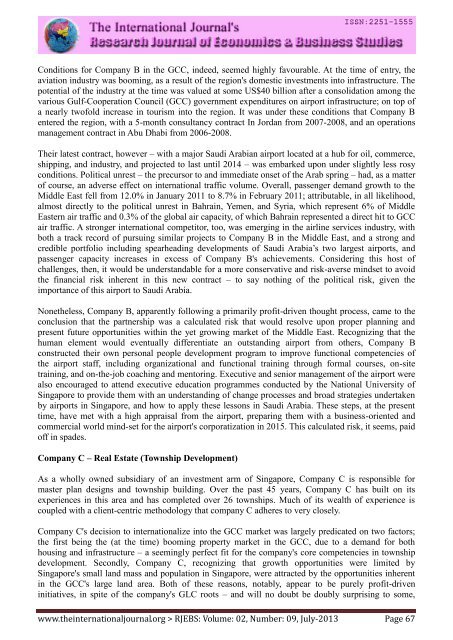Research Journal of Economics & Business Studies - RJEBS - The ...
Research Journal of Economics & Business Studies - RJEBS - The ...
Research Journal of Economics & Business Studies - RJEBS - The ...
You also want an ePaper? Increase the reach of your titles
YUMPU automatically turns print PDFs into web optimized ePapers that Google loves.
Conditions for Company B in the GCC, indeed, seemed highly favourable. At the time <strong>of</strong> entry, the<br />
aviation industry was booming, as a result <strong>of</strong> the region's domestic investments into infrastructure. <strong>The</strong><br />
potential <strong>of</strong> the industry at the time was valued at some US$40 billion after a consolidation among the<br />
various Gulf-Cooperation Council (GCC) government expenditures on airport infrastructure; on top <strong>of</strong><br />
a nearly tw<strong>of</strong>old increase in tourism into the region. It was under these conditions that Company B<br />
entered the region, with a 5-month consultancy contract In Jordan from 2007-2008, and an operations<br />
management contract in Abu Dhabi from 2006-2008.<br />
<strong>The</strong>ir latest contract, however – with a major Saudi Arabian airport located at a hub for oil, commerce,<br />
shipping, and industry, and projected to last until 2014 – was embarked upon under slightly less rosy<br />
conditions. Political unrest – the precursor to and immediate onset <strong>of</strong> the Arab spring – had, as a matter<br />
<strong>of</strong> course, an adverse effect on international traffic volume. Overall, passenger demand growth to the<br />
Middle East fell from 12.0% in January 2011 to 8.7% in February 2011; attributable, in all likelihood,<br />
almost directly to the political unrest in Bahrain, Yemen, and Syria, which represent 6% <strong>of</strong> Middle<br />
Eastern air traffic and 0.3% <strong>of</strong> the global air capacity, <strong>of</strong> which Bahrain represented a direct hit to GCC<br />
air traffic. A stronger international competitor, too, was emerging in the airline services industry, with<br />
both a track record <strong>of</strong> pursuing similar projects to Company B in the Middle East, and a strong and<br />
credible portfolio including spearheading developments <strong>of</strong> Saudi Arabia’s two largest airports, and<br />
passenger capacity increases in excess <strong>of</strong> Company B's achievements. Considering this host <strong>of</strong><br />
challenges, then, it would be understandable for a more conservative and risk-averse mindset to avoid<br />
the financial risk inherent in this new contract – to say nothing <strong>of</strong> the political risk, given the<br />
importance <strong>of</strong> this airport to Saudi Arabia.<br />
Nonetheless, Company B, apparently following a primarily pr<strong>of</strong>it-driven thought process, came to the<br />
conclusion that the partnership was a calculated risk that would resolve upon proper planning and<br />
present future opportunities within the yet growing market <strong>of</strong> the Middle East. Recognizing that the<br />
human element would eventually differentiate an outstanding airport from others, Company B<br />
constructed their own personal people development program to improve functional competencies <strong>of</strong><br />
the airport staff, including organizational and functional training through formal courses, on-site<br />
training, and on-the-job coaching and mentoring. Executive and senior management <strong>of</strong> the airport were<br />
also encouraged to attend executive education programmes conducted by the National University <strong>of</strong><br />
Singapore to provide them with an understanding <strong>of</strong> change processes and broad strategies undertaken<br />
by airports in Singapore, and how to apply these lessons in Saudi Arabia. <strong>The</strong>se steps, at the present<br />
time, have met with a high appraisal from the airport, preparing them with a business-oriented and<br />
commercial world mind-set for the airport's corporatization in 2015. This calculated risk, it seems, paid<br />
<strong>of</strong>f in spades.<br />
Company C – Real Estate (Township Development)<br />
As a wholly owned subsidiary <strong>of</strong> an investment arm <strong>of</strong> Singapore, Company C is responsible for<br />
master plan designs and township building. Over the past 45 years, Company C has built on its<br />
experiences in this area and has completed over 26 townships. Much <strong>of</strong> its wealth <strong>of</strong> experience is<br />
coupled with a client-centric methodology that company C adheres to very closely.<br />
Company C's decision to internationalize into the GCC market was largely predicated on two factors;<br />
the first being the (at the time) booming property market in the GCC, due to a demand for both<br />
housing and infrastructure – a seemingly perfect fit for the company's core competencies in township<br />
development. Secondly, Company C, recognizing that growth opportunities were limited by<br />
Singapore's small land mass and population in Singapore, were attracted by the opportunities inherent<br />
in the GCC's large land area. Both <strong>of</strong> these reasons, notably, appear to be purely pr<strong>of</strong>it-driven<br />
initiatives, in spite <strong>of</strong> the company's GLC roots – and will no doubt be doubly surprising to some,<br />
www.theinternationaljournal.org > <strong>RJEBS</strong>: Volume: 02, Number: 09, July-2013 Page 67
















